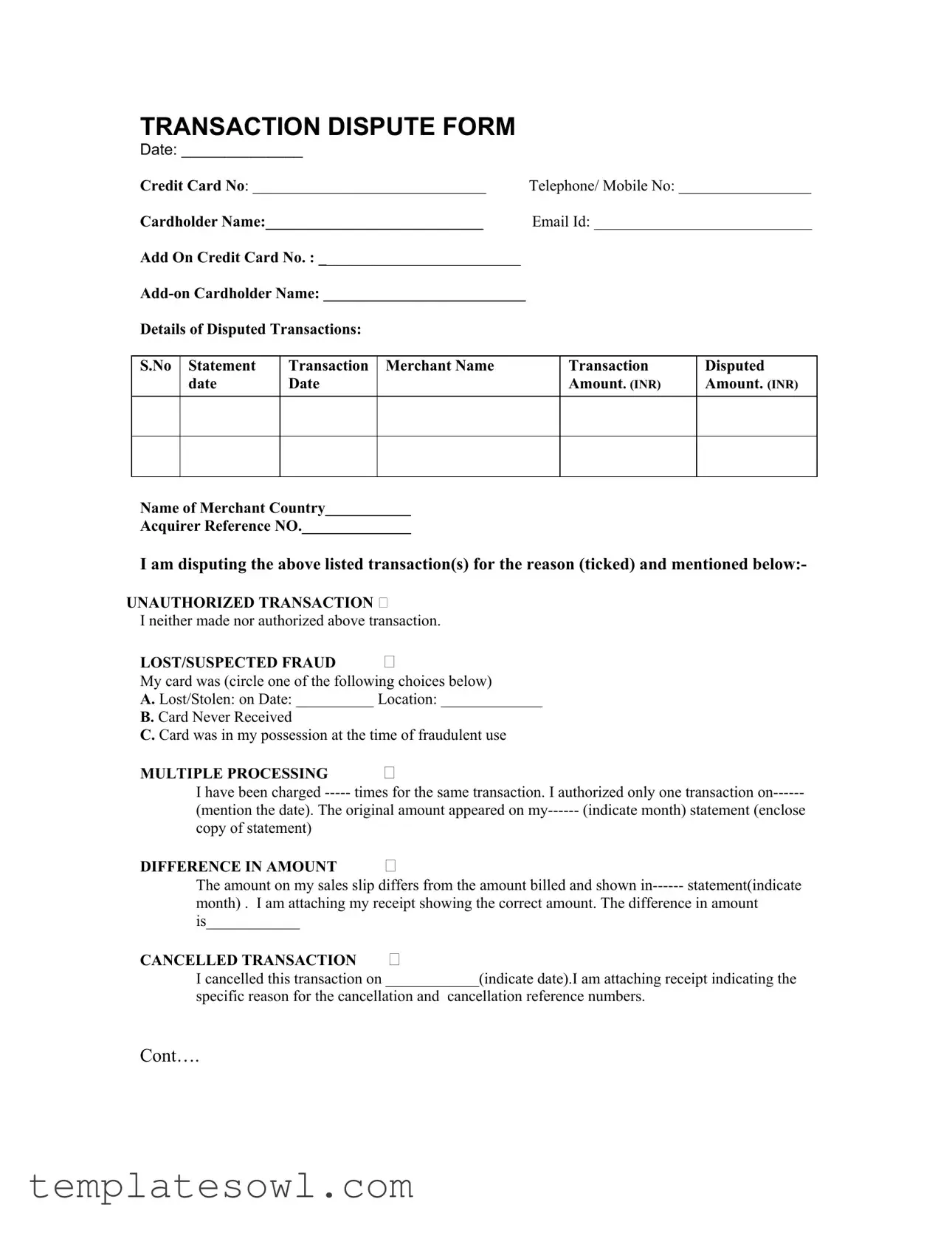TRANSACTION DISPUTE FORM
DATE: ______________
Credit Card No: ______________________________ |
Telephone/ Mobile No: _________________ |
Cardholder Name:____________________________ |
Email Id: ____________________________ |
Add On Credit Card No. : __________________________ |
|
Add-on Cardholder Name: __________________________ |
|
Details of Disputed Transactions: |
|
Transaction Merchant Name Date
Transaction Amount. (INR)
Name of Merchant Country___________
Acquirer Reference NO.______________
I am disputing the above listed transaction(s) for the reason (ticked) and mentioned below:-
UNAUTHORIZED TRANSACTION
I neither made nor authorized above transaction.
LOST/SUSPECTED FRAUD
My card was (circle one of the following choices below)
A. Lost/Stolen: on Date: __________ Location: _____________
B. Card Never Received
C. Card was in my possession at the time of fraudulent use
MULTIPLE PROCESSING
I have been charged ----- times for the same transaction. I authorized only one transaction on------
(mention the date). The original amount appeared on my------ (indicate month) statement (enclose
copy of statement)
DIFFERENCE IN AMOUNT
The amount on my sales slip differs from the amount billed and shown in------ statement(indicate
month) . I am attaching my receipt showing the correct amount. The difference in amount is____________
CANCELLED TRANSACTION
I cancelled this transaction on ____________(indicate date).I am attaching receipt indicating the
specific reason for the cancellation and cancellation reference numbers.
Cont….
DEFECTIVE MERCHANDISE
I am disputing the quality of goods/services I received from merchant. I have contacted the merchant/retailer . The response to my request for refund, is stated on annexure attached herewith.
CREDIT NOT RECEIVED
I was given a credit slip in the amount of _____________on_________ (DD-MM-YYYY) by the merchant
retailer which has not yet appeared on my billing------- Statement (indicate month) The copy of the credit
slip is attached.
PAID BY OTHER MEANS |
|
|
I paid for the transaction by Cash |
Cheque Draft |
Other credit card. I attach |
cash receipt |
or copy of cheque / Cheque no. alongwith Bank statement orother credit card |
statement. |
|
I have returned the merchandise and requested a refund from the Merchant retailer and have forwarded a copy of the proof of return to him. I attach proof of return herewith.
The goods/services are different from what was ordered or described. On attached sheet I have explained what was expected, what was received, and indicated my attempt to return the goods. The proof of return is also attached.
GOODS / SERVICES NOT RECEIVED
I have not received the goods/services and for that reason,I contacted the Merchant/retailer
on___________(DD-MM-YYYY) . The merchant response to my request for a refund or delivery date is
given on separate attached sheet .The copy of letter to the merchant attempting to resolve the dispute is enclosed.
ATM DISCREPANCY
The amount on my ATM slip differs from the amount billed in statement. Attached is my receipt showing the correct amount. The difference in amount is ______________ or I
did not receive cash from ATM.
ANY OTHER (Give full details)
Primary Cardholder Signature: _________________________________
Add-on cardholder Signature: ____________________________(mandatory if the
transactions disputed are done through the Add on Card)
IMPORTANT NOTE
•Cardholder is requested to submit card statement highlighting disputed transaction and required documents wherever it is requested
•After dispute charges are resolved, should such charges recur in the statement, you are requested to intimate the Bank for these disputed charges vide this form within 30 days of statement date to enable us to take up the dispute with the member banks. After the lapse of 30 days, it will be construed that all the charges are acceptable and in order.
•A retrieval fee as prescribed in schedule of charges will be levied on per transaction basis to your account


